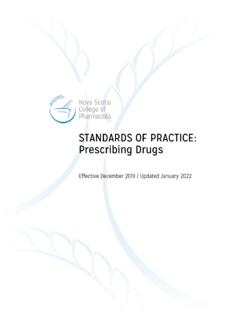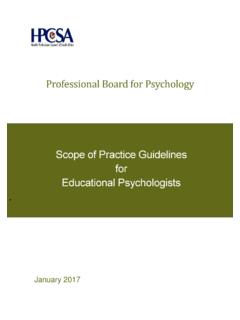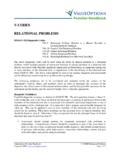Transcription of Standards of Practice: Opioid Agonist Maintenance ...
1 Standards OF PRACTICE: Opioid Agonist Maintenance Treatment Services June 2017 Standards OF PRACTICE: Opioid Agonist Maintenance Treatment Services Nova Scotia College of Pharmacists / June 2017 1 TABLE OF CONTENTS Table of Contents 1 Acknowledgements 2 1 Background 3 2 Purpose 4 3 Terminology 5 4 Ethical Considerations 6 5 Standards of Practice 7 Appendix A Substance Use Screening and Brief Intervention Tool 10 Appendix B References 11 Appendix B-1 Designated Resources 12 Appendix C Pharmacy OAMT Registration Form 14 Appendix D OAMT Legal Requirements 15 Appendix E Preparation of Doses 19 Appendix E-1 Methadone Stock Solution Compounding Log 23 Appendix E-2 Methadone Individual Dose Compounding Log 24 Appendix E-3 Alternate Methadone Individual Dose Compounding Log 25 Appendix F Preparation of Doses Using Methadone Compounding Devices 26 Appendix G Patient Assessment 28 Appendix G-1 Patient
2 Assessment Tool 31 Appendix H Dispensing and Administration of Doses 32 Appendix H-1 Take-Home Doses 35 Appendix H-2 Daily Witnessed Ingestion and Take-Home Dose Log 40 Appendix H-3 Take-Home Dose Log - 4 or More Doses 41 Appendix H-4 Appropriate Action for Administration Errors 42 Appendix I Special Circumstances 44 Appendix J OAMT prescription Adjustment Form 48 Appendix K Incident Report Form 49 Appendix L Against Medical Advice 50 Notes 51 Standards OF PRACTICE: Opioid Agonist Maintenance Treatment Services Nova Scotia College of Pharmacists / June 2017 2 ACKNOWLEDGEMENTS The Nova Scotia College of Pharmacists (NSCP) gratefully acknowledges the consent of the following organizations to allow inclusion of portions of their documents in these Standards : The Centre for Addiction and Mental Health (CAMH) publication, Opioid Agonist Maintenance Treatment A pharmacist s guide to methadone and buprenorphine for Opioid use disorder, Third Edition The College of Physicians and Surgeons of Nova Scotia (CPSNS), Methadone Maintenance Treatment Handbook, 2017 The NSCP appreciates the assistance and guidance of the many individuals who participated in creating these revised Standards , and in particular the Nova Scotia College of Pharmacists (NSCP) advisory groups: The Drugs of Abuse Issues Advisory Group, and The Standards of Practice Advisory Committee.
3 External Review and Contributors The NSCP recognizes that Opioid use disorder is a challenging issue for patients, communities and health care providers. Opioid Agonist Maintenance treatment (OAMT) is an essential service and pharmacists have a critical role to play as members of the patient s care team. The NSCP appreciates the contributions of the following stakeholder organizations to these Standards : College of Pharmacy, Dalhousie University College of Physicians and Surgeons of Nova Scotia College of Registered Nurses of Nova Scotia Pharmacy Association of Nova Scotia Provincial pharmacy regulatory authorities Standards OF PRACTICE: Opioid Agonist Maintenance Treatment Services Nova Scotia College of Pharmacists / June 2017 3 1 BACKGROUND Opioid use disorder is a chronic and relapsing illness, which can cause severe decline in the individual s physical and psychological health, unemployment and family disruption.
4 Desperation of those in its grip can sometimes lead to participation in illegal activities. Treatment for Opioid use disorder requires efforts and collaboration of a multidisciplinary team and multidimensional treatment options, including Opioid Agonist therapy with methadone or buprenorphine/naloxone. It is a critical service and, as described by the following patients, provides individuals with an opportunity to manage their condition, improve their quality of life and benefit society. Methadone has given me time to find myself. It pulled me off the streets and has given me a chance to be a better father, friend, brother and husband. Now I am close to the finish line with my treatment and have everything I've ever wanted .. my life. Without the help that I ve received through the methadone program, many different doctors, counsellors and a great pharmacy team, I m not sure where I d be today.
5 My life now is very different from what it could have been. I live now with purpose. Pharmacy professionals play a critical role in the healthcare team providing Opioid Agonist Maintenance treatment (OAMT). The decision by a pharmacy to provide OAMT services requires thoughtful consideration of professional ethics (see Ethical Considerations, ) and also of the capacity of the pharmacy to undertake the associated activities safely and effectively. When the NSCP established the Methadone Maintenance Treatment Services: Standards of Practice for Community Pharmacies in Nova Scotia, methadone was the primary medication therapy for treatment of Opioid use disorder. In this 2017 edition, the NSCP has retitled and broadened the scope of the Standards to incorporate practice expectations when providing both methadone and buprenorphine/naloxone as opiate Agonist Maintenance treatment.
6 In addition, the format of the Standards has been updated and streamlined. Clinical details and other resources, previously included in the body of the Standards , are provided in the appendices as reference and supporting information. Standards OF PRACTICE: Opioid Agonist Maintenance Treatment Services Nova Scotia College of Pharmacists / June 2017 4 2 PURPOSE The primary goal of this Standards of Practice: Opioid Agonist Maintenance Treatment document is to support the safe and effective provision of opiate Agonist Maintenance services by pharmacists and pharmacy technicians in Nova Scotia to Opioid dependent individuals, contributing to improved patient and societal outcomes. These Standards establish the expected practice of pharmacists and pharmacy technicians when providing methadone or buprenorphine/naloxone in the treatment of substance use disorder (formerly methadone Maintenance treatment (MMT) services).
7 Note that the Control Drugs and Substances Act (CDSA) and its regulations do not authorize pharmacy technicians with respect to certain activities in the provision of this treatment. As such, these Standards explicitly state the activities a pharmacy technician is permitted to undertake. While methadone and buprenorphine/naloxone are also used in the treatment of chronic pain, these Standards do not address the provision of these medications to patients for these indications when there is no concern of previous or current substance use disorder Note that certain clinical details, including for example, information regarding OAMT in special populations, and other resources previously included in the body of the Standards , are provided in the appendices as reference and supporting information. Standards OF PRACTICE: Opioid Agonist Maintenance Treatment Services Nova Scotia College of Pharmacists / June 2017 5 3 TERMINOLOGY Descriptions of the terms used in the Standards of Practice: Opiate Agonist Maintenance Treatment are provided in the following table.
8 Harm Reduction Harm reduction refers to policies, programs and practices that aim to reduce drug-related harm without requiring the person to stop using the substance. Harm reduction strategies aim to reduce drug-related harms not just for the user, but also for families, friends and communities. The approach is based on the belief that it is in both the user's and society's best interest to minimize the adverse consequences of drug use when the person is unable or unwilling to discontinue using. Here are some examples: Methadone Maintenance treatment programs are based on research evidence indicating that when the goals of treatment retention and abstinence appear to be in conflict, it is usually more beneficial to give priority to treatment retention and withdrawal management. Psychoeducational approaches focus on providing practical information to help people manage the risks associated with substance use.
9 Topics include safer injection procedures and alternative routes of administration; needle distribution; and infections caused by HIV, hepatitis B and C, tuberculosis and sexually transmitted diseases. From CAMH Portico Network Trauma Events that involve actual or threatened death or injury or threats to physical integrity and the experiences of helplessness, fear and horror these events elicit from trauma survivors. Criteria A1 and A2 respectively in the definition of PTSD, American Psychiatric Association, 1994 Trauma Informed Care Trauma-informed services do not need to be focused on treating symptoms or syndromes related to trauma. Rather, regardless of their primary commitment is to provide services in a manner that is welcoming and appropriate to the special needs of those affected by trauma.
10 A Trauma Informed Approach to Screening and Assessment, Harris & Fallot, 2001. Standards OF PRACTICE: Opioid Agonist Maintenance Treatment Services Nova Scotia College of Pharmacists / June 2017 6 4 ETHICAL CONSIDERATIONS While society has gained increased understanding of the wide-ranging contributors to the development of substance use disorders, including trauma and toxic stress, many continue to view substance use disorder as a bad choice or a moral failing. Accordingly, persons with substance use disorders often find themselves stigmatized or blamed for their condition by wider society and this stigmatization can make the afflicted person s recovery even more difficult. Unfortunately, health care providers can themselves perpetuate some of this stigma. Pharmacists are encouraged to reflect on their own biases and understandings, consider how these might affect their approach and either impede or support a patient s recovery.






